Sue Burke's Blog, page 69
March 19, 2014
Go Ahead — Write This Story: Titles
If you need an idea for a story to title, here are a few:
• This is a young adult story (but not a dystopia) about a child whose IQ has been artificially accelerated and who can now memorize anything, but understands little – for example, the child can memorize mathematical theorems but cannot solve a math word problem.
• This is a gritty urban fantasy about a person whose mere presence makes people happy: a curse, perhaps, considering what happens when this syndrome and its cause become widely known.
• This is a space opera thriller about secret agreements meant to prevent another interplanetary war, but of course they only make things worse.
— Sue Burke
March 12, 2014
Ten years and one day after the train bombing in Madrid
On the next day, March 12, protest marches were organized nationwide. At the time, due to deliberate government misinformation — national elections were being held on March 14 — we still believed that ETA, the Basque terrorist organization that had already killed hundreds of people, might be behind the attacks.
My husband and I took part in the protest in Madrid. This is my account from 2004.

Madrid Is Weeping
I had studied mass transit maps, I had a plan: After Spanish class, Jerry and I would catch a number 37 bus two blocks from the academy. That would take us to Plaza de Colón — actually, probably not. If a million people came to the protest march, and I hoped they would, the bus wouldn't get all the way to there. But it would get us closer.
The march was set to begin at 7 p.m., which was when the class ended, and Plaza de Colón, where the march would start, was only a kilometer and a half away, so the trip wouldn't be long, and being a few minutes late wouldn't hurt. Anything in Spain that involved a million people wouldn't start on time anyway.
Through the classroom windows, we saw people heading down the street towards the protest, and I was glad. I wanted the biggest protest march in the history of Madrid. Almost two hundred people riding commuter trains had been killed the day before by terrorist bombs. I had heard some of the bombs. Sometimes my husband took those trains. The terrorists could have killed Jerry, and I would have heard it happen.
Class ended. Our tutor sent us off with good wishes — she had a small child and couldn't go herself, though she wanted to. It was raining hard outside, but the weather report said it was supposed to taper off as time went on.
A bus came quickly, packed with so many people that we entered by the exit door, but the buses were free anyway so that people could get to the protest. We passed a clinic. Because there had been hundreds and hundreds of injuries from the bombing, clinics could not shut down the way other businesses had, but at the doorway, white-smocked people stood on the sidewalk under umbrellas, holding candles, briefly joining the protest as best they could.
The bus got about a half a kilometer farther, then a river of people at a cross-street stopped it. "Does anyone know if this is where we get off for the protest?" a gray-haired woman shouted, and everyone laughed. We all got out, opened our umbrellas, and joined the crowd.
A half-kilometer later, at 7:30 p.m., we entered Plaza de Alonso Martínez, a traffic circle, and we stopped moving. The rain began to fall harder. The temperatures were in the upper 40sF / 8C. Fifteen minutes later, we had shuffled to the far side of the circle. A man finished a conversation on his cell phone, then announced, "The subways are filled to overflowing. The trains can't take pick up any more people. They just have to keep waiting on the platforms."
Maybe as a defense against the miserable weather, the protesters seemed cheerful — although, that morning, I had seen people weeping in the street on their way to work. Maybe everyone felt relieved because they were doing something in response to the bloodshed. Young people had come especially energized, with signs, decorated umbrellas, face paint, Spanish flags hung with black mourning bands, and candles. Students in Spain protest a lot. They knew what to do.
The crowd inched forward, then parted to let an ambulance through. "A drowning victim," Jerry joked. The rain diminished a bit, but my toes inside boots and two pairs of socks began to feel wet. Step by step, by 8:30 we made it to Plaza de Colón with its bright television lights and cameras from networks from around the world, the reporters and their equipment draped in plastic. The pace picked up and twenty-somethings began chanting:
"No estámos todos. Faltan dos cientos." We're not all here. We're missing two hundred.
"Damos la espalda al terrorismo." We turn our backs on terrorism. This involved walking backwards, with a little stumbling and laughter.
"Hijos de puta." Sons of bitches — directed at the terrorists and sung to a soccer cheer. The twenty-somethings liked this a lot.
"ETA y Al Qaeda, misma mierda." Basque terrorists and Al Qaeda, the same shit.
"Ibamos todos en ese tren." We were all riding on that train.
"No está lloviendo. Madrid está llorando." It's not raining. Madrid is weeping.
By 9:15 we had reached the Prado Museum, and the march spread out onto its sidewalks. The weather turned colder, the rain began falling harder, the pavement streamed with water, and my feet felt much wetter. "With all this rain, we're going to grow like plants," a woman said.
We finally squeezed past Atocha train station, where more than a hundred people had died the day before. The twenty-somethings stopped marching and stood, chanting, displaying signs for the banks of television cameras there. They had built a shrine on the huge fountain in the middle of the traffic circle in front of the train station with flowers and signs and candles, which they relit as fast as the raindrops put them out — for peace, liberty, democracy, and the victims.
We had walked over three kilometers in all. We now joined the streams of people headed toward their homes, crowding the sidewalks of the neighborhood where we lived. It was 10 p.m. We got to our apartment, and I set the dripping umbrellas in the bathtub, put on dry socks, sat down on the sofa exhausted, and turned on the television. The drenched twenty-somethings were still going strong, to the astonishment of the reporters at Atocha.
And they said that more than two million people had come to the protest.
— Sue Burke
March 10, 2014
The real “300”
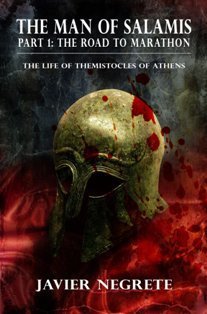
I’d like to recommend a realistic historical novel about it, Salamis, by Javier Negrete, an award-winning Spanish writer. Like all his work, the story is taut, three-dimensional, and rich in detail. And accurate. Negrete has a degree in Classical Languages – he speaks Ancient Greek. That helps a lot.
Right now, the novel is still being translated into English and should be available later this year. Meanwhile, you sample the beginning and see if it’s what you were hoping for:
The Man of Salamis. Part 1: The Road to Marathon
http://www.amazon.com/dp/B00IUJP0JE
History doesn’t get treated better than this.
— Sue Burke
March 5, 2014
Demons on campus: The Royal Academy at Osyth
She's been hanging around university science departments all her life - even longer, since her mother was pregnant with her while she was a grad student. Pat has a PhD. in zoology, which may explain the realistic ecology of magic in the stories, and she teaches at a small Midwest college. She has a shrewd eye for personalities, with their strengths, foibles, and secrets.
She's written a series of novels and short stories about Osyth, and I love them all.
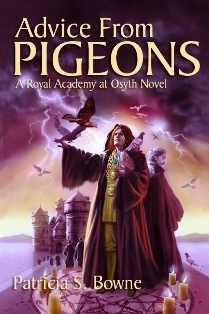
Her inspiration? Graduate school.
I'm always drawing on that - not that any of my professors were attacked by demons! I went to such interesting grad schools, with things like whale skeletons buried in the volleyball pit, deep-sea sampling expeditions, students chasing down pronghorns in winter and sampling lakes during snowstorms, or running into bears on their sampling transects - how could I not miss all that when I went into teaching? There's a part in the first novel where Warren wishes he was a painter, just so he could record what the offices look like. I felt that way every day when I was in grad school. So I finally have recorded it, if in an altered form.
What's the Royal Academy at Osyth like?
It's like a large modern university, an R1 [advanced research institution] with medical school (sorcery) and engineering school (wizardry). The Demonology Department is about equivalent to the biology department at a real university; it's in the school of Natural Magic. The Royal Academy has two other schools, Social Magic (roughly equivalent to the social sciences) and Arcane Arts (the humanities and Fine Arts). I've toyed with adding a business program for non-magical students, since as a Royal Academy they have to accept any of the Royal family whether they're talented or not, but haven't written anything about it yet.
I wanted it to be a real university, with the kinds of issues that a real university has - for instance, insurance coverage, faculty meetings, program evaluations, all those things that seem to be imposed from some nebulous upper region (that's why the Dean doesn't have a name). Folks who write about universities of magic sometimes treat them as if faculty just do whatever interests them until they cry "voila!" and emerge with some new threat to humanity in their back pockets. But in real life, what government would allow that? All my faculty work under bureaucratic constraints. The most extreme example is Bill Navanax, who might be burned at the stake if he takes his work out of the lab.
I'm told that the most realistic part of Advice From Pigeons is the stress on a new faculty member. Rho really does need to get his research going and get a grant ASAP, and the culture clash he goes through on moving from Kasidora to the Royal Academy is real. A friend of mine who just read the book says it captures the new faculty experience, and I see the things I wrote about reflected in faculty blogs.
There are some areas I didn't observe when I was in grad school; for instance, I don't know what kinds of meetings profs at an R1 have to attend, so I draw that from what I've seen in liberal arts colleges. In the short story "Kindling," everybody wants to be on the Library Use Committee; I'm on that one myself and it is a plum, though not for the reason given in the story. Likewise I knew nothing about Development from grad school, so I hope the fundraising in Want's Master is accurate.
There's humor ...
I think academic life is that humorous. It's in-jokes, of course. I remember laughing at a grad school party about something regarding sewage bacteria, and thinking, "This is the life - to know people who get this joke." Grad school is full of clever people with a fund of specialized knowledge, some of which is just funny on its own and some of which becomes funny when you try to link it to real life; like a friend of mine who studied foraminifera, and identified truck hubcaps according to which foram shell they resembled. That sort of thing goes on all the time in grad school. The trick is to make it funny to people who aren't in the field.
… and there's danger.
People do do dangerous things in academic science. There's a documentary out there that shows one of my classmates scrambling up an observation tower just ahead of a polar bear. I had a couple office-mates who were standing atop a dead whale when it exploded. I think half the people I know from those years have been in swimming with sharks, worked with potentially lethal or explosive toxins, so forth.
But nothing like getting their hands torn off by demons. The daily invocation of a demon isn't realistic in any sense; especially, I can't imagine a whole department getting together every morning to do something that is really only relevant to four or five members' research. When Linus complains about giving an hour of his time to it every day, he has a legitimate gripe.
Osyth took shape before </i>Harry Potter,</i> but the two worlds have been compared.
Hogwarts is from a whole different tradition; the biggest difference, though, would be that the Harry Potter books are about the students, while my books are about the profs. Hogwarts is a teaching establishment, and the Royal Academy is a research university. Students barely appear in my books, and when they do they are graduate students. Which I think is pretty accurate; in all my years of grad school, I can't remember ever hearing a prof talk about teaching undergraduates, even though they were all doing it.
At Hogwarts, disciplines seem to be divided methodologically. Transformation, or potion-making. At the Royal Academy, folks are divided by what they specialize in. Will Harding, for instance, would know any potions and transformations relevant to vampires. But that's because this is a higher level of education, and all these people are far past the skills-level classes Harry Potter is taking.
Hogwarts celebrates things like Christmas, if I remember correctly. There's no hint of any of that in Osyth. In fact, it's a pretty religion-free country at the time of these novels. A church does open there in </i>A Lovesome Thing,</i> and the building they use was a church in the far past. However, gods are real enough for the Academy to have hired a specialist in them. Basically, divine forces are real but most human religions cycle in and out of being bunk. There's a lot about religions in </i>A Lovesome Thing,</i> and a lot about gods in my most recent novella, "Those Who Favor Fire."
The in-jokes include naming demons after fish.
That started with Nezumia. In real life it's a macrourid (grenadier or rattail), one of the deep sea fishes I did my masters' on. Another researcher in the area told me that its name meant "black rat" in Japanese. Google now tells me that isn't true, but this was back before Google … Anyway, I thought "Black Rat" was a fine name for a demon from the netherworld. In fact, all these deep-sea fishes seemed as if they would make good models for demons from the netherworld; besides which they had been a royal pain to study, so there was an element of revenge.
Once I started using scientific names, I branched out from fish. I figure anyone deep enough into science to get the in-jokes will be deep enough into it to enjoy the rest of the books.
What you can read about Osyth (and buy here):
• Advice From Pigeons, a novel. Hiram Rho starts work at the Academy, and within a month, he has acquired an affectionate demon with a plan to take over the department, the two senior demonologists have lost their souls and their health insurance, and Rho's problems have embroiled everyone from the mysterious Alchemy faculty to the pigeons on his window ledge.
• A Lovesome Thing, a novel. It's spring break. Demonology faculty have scattered to the four winds except for Neil Torecki and Teddy Whin, who venture into the alchemists' study garden to rescue a lost colleague. They don't know that the garden opens into an ancient prison for dissident alchemists, or that the world's most dangerous possessing demon has taken refuge there, feeding on the prisoners while it plots to take over leadership of a major religion.
• Want's Master and Other Stories From Osyth, a collection of four Osyth stories: "Want's Master," about a development officer who enchants donors; "Kindling," in which Linus takes over the world's most dangerous research museum; "Beginner's Luck," where Anders Regan gets embroiled in dryad rights and the theology of conference door prizes; and "Unite and Conquer," in which a grad student at the University of Kasadora takes revenge on her abusive advisor.
• "Those Who Favor Fire," a story at Lorelei Signal. Winston Chiliming, a mysterious diviner, refuses to be categorized - even into male or female. The magazine has a voting system, so if you like the story you can indicate it by donating to the magazine and help support it.
• Swept and Garnished, a novel coming out later this year. After barely surviving the semester at the Royal Academy, Hiram Rho heads home for the summer and his department chair, Warren Oldham, departs on a well-deserved vacation. While Rho tries to get his powers back, Warren's vacation takes an unexpected turn that leaves him battling a demon from inside it. Back in Osyth, Russell Cinea, the senior demonologist, is finally in charge - for a week full of demons, exorcists, and unexpected temptations.
• More Royal Academy novellas will be re-issued this year, and perhaps another collection.
— Sue Burke
February 23, 2014
Independence Square, Ukraine
I went to Kiev, Ukraine, for the 2006 Eurocon, the 28th European Science Fiction Convention. I had a little time to see the city, which is lovely and elegant, and to take this photo:
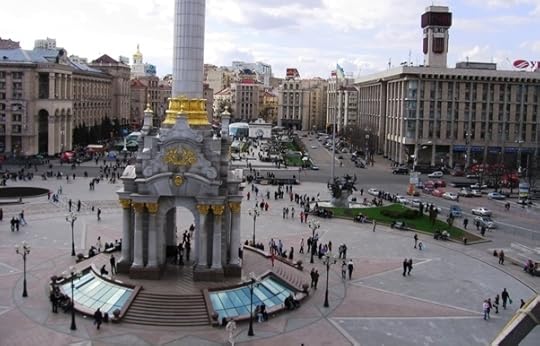
Independence Square (Maidan Nezalezhnosti) got its name in 1991 when Ukraine became independent from the USSR, but it has existed since 1869, and it has had many names and designs. At the center of the photo is the gilt base for a tall pillar topped with a statue of the goddess Berehynia, placed there after the most recent remodeling in 2001.
Over the years, the square has been the site of many political rallies, such as the Orange Revolution in 2004 and, starting in November 2013, Euromaidan. Here is a photo from the Washington Post from February 20:
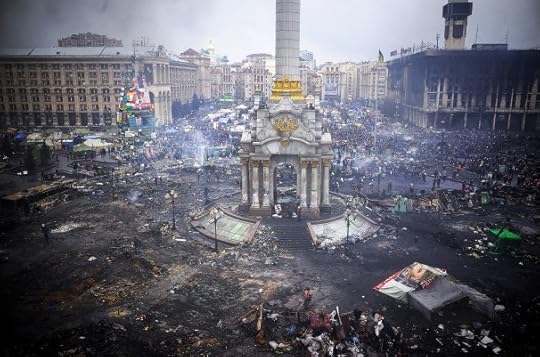
A few days in Kiev hardly makes me an expert, but I can tell you one thing: the area in which the protests took place is small, just that downtown square and a couple of blocks of the surrounding streets. It hurt to see the flames and blood.
And I know enough about the issues behind the protest to understand that they include not just the future of Ukraine but the future of Russia and Putin, and the European Union. Or Russia vs. the European Union. José Ignacio Torreblanca, a columnist for El País newspaper in Spain, has even suggested that the conflicts in Syria and Ukraine are part of a cold war between Russia and the EU.
These are tough times for democracy.
— Sue Burke
February 19, 2014
Go Ahead — Write This Story: Matters of size
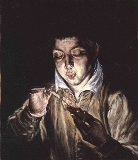
A simple picture can be a short-short story. (Boy Lighting a Candle, by El Greco, 1571)
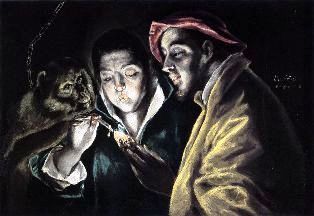
Add a few more characters, and you have a longer short story. (An Allegory with a Boy Lighting a Candle in the Company of an Ape and a Fool, by El Greco, 1577)
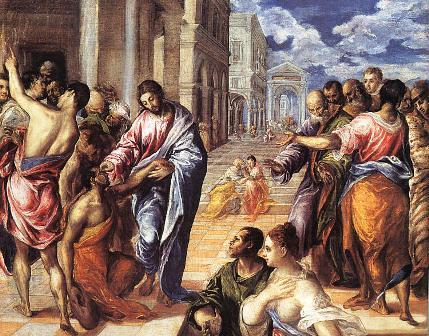
With more characters and more conflict, you might have a novel. (The Miracle of Christ Healing the Blind, by El Greco, ca. 1570)
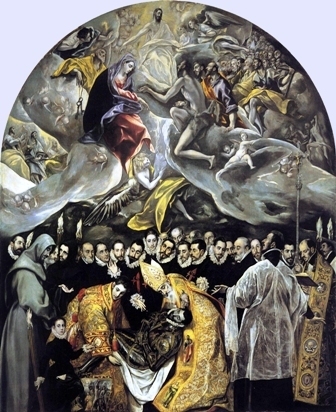
A big canvas with a lot happening could well be a three-novel series. (The Burial of the Count of Orgaz, by El Greco, 1586. The painting is 15 feet tall.)
Here are a few story ideas:
• The glowing little fairy was fragile and needed help to stay alive.
• The glowing little fairy was fragile, but it attracted too much attention, and the boy wasn’t sure he could keep it safe.
• Jessie’s unusual but successful medical techniques often got him into trouble, and eventually he faced a death sentence.
• The Count’s death unleashed an epic conflict between men and God. (Notice the lack of women at the Count’s funeral. I think they’re all off reading Lysistrata.)
— Sue Burke
This year is the 400th anniversary of the death of El Greco in Toledo, which we’re celebrating here in Spain. Visit the official website or learn more at this news article from the Telegraph.
February 17, 2014
Exploring En Papel: writing in another language
What’s it like to write in another language? It’s not just changing the words from one language to another, sort of like Google Translate. Techniques for beautiful or powerful prose in one language are not the same in another. Different linguistic resources offer distinctive possibilities and restraints. In every language, history weighs heavily on word choice. Even somewhat close languages like Spanish and English have what we might call different operating systems.
That’s why Estefanía Gonzáles and I have teamed up for Exploring En Papel, a bilingual Spanish- English creative writing workshop meant to help writers take a step toward perfection in their second language. It starts on March 8 and will be presencial in Madrid, Spain. The class will be small: no more than eight students. You’ll get in-class exercises, reading, homework (hey, we’re teachers), and individualized correction and attention.
You can see more at:
http://exploringenpapel.wordpress.com/
Contact us at:
exploringenpapel@gmail.com
Languages limit not what you can say but what you must say. Creativity understands limits and turns them into effective tools.
— Sue Burke
February 12, 2014
The divine origin of mustaches and bigots
In 1483, Holy Roman Emperor Charles V arrived in Spain with German-speaking Swiss Guards. They were noted for their impressive mustaches and their tendency to say “bei Got!” (“By God!”). Spaniards began to use bigot first as a name for them and later for their memorable upper-lip hair. The word eventually became Hispanicized into bigote, pronounced “bee-GO-tay.”
The English word is about a century younger. The French Beguines, a Catholic lay sisterhood, also had a tendency to say “by God,” but they were noted for their excessive and hypocritical devotion. The word bigot was coined in French with the sense of a foolishly obstinate or opinionated person. The world crossed the Channel and became part of English. Eventually the stress came to fall on the first syllable and the opinion came to be centered on intolerance.
When words migrate from one language to another, they don’t always arrive safely.
— Sue Burke
February 5, 2014
Spain’s word of 2013: escrache
Why this word? It says a whole lot about what happened in Spain in 2013. According to Google, it was one of the most searched-for words in Spanish last year.
Spain has never had a word of the year before. Fundéu BBVA, the Foundation for Urgent Spanish, was started in 2005 to answer questions about the proper use of Spanish for the media. This year, it decided to find a word of the year that fit the foundation’s reason for being. “We looked for a word that had some interest from a linguistic point of view, whether for its origin or how it was formulated, and that has been on the front page in recent months,” said Joaquín Muller, general director of Fundéu BBVA.
It considered twelve words, including expapa, which was used for the first time in history, describing a pope who had renounced the Holy See. Other candidates were autofoto or “selfie”; austericidio or “austericide” in reference to economic hardship brought on by government budget cuts; and similar words drawn from economics and social networks.
Escrache came into use in Argentina and Uruguay in the 1990s during investigations of crimes committed during their dictatorships. Its origin is unclear. Perhaps it came from the Italian words for “smash” or for “spit”; Argentina has a lot of Italian immigrants. Or it may have come from the English word scratch. It came to mean “holding someone accountable.”
The word arrived in Spain in 2013 to describe the protests organized by People Affected by Mortgages (PAH). That group says that mortgages in Spain are created in a way that benefit banks at the expense of homeowners. For example, if your mortgage is foreclosed and you are evicted in Spain, you must continue to pay the mortgage unless the bank manages to sell the property for enough money to make a profit, and banks often use straw buyers to make sure the sale price is always too low. And in Spain, you can’t declare bankruptcy.
Due to the epidemic of foreclosures as a result of Spain’s ghastly economy — 27% unemployment — PAH proposed changes to the law. Lawmakers resisted making changes, and in early 2013 PAH began to organize escraches in front of lawmakers’ homes to urge them to support the bill. To the politicians, this was “violent harassment.” Mortgage laws didn’t change much in 2013, but escraches were promptly prohibited.
Oxford went with selfie as the English word of the year for 2013. That word did appear in the news fairly often, usually in gossip pages. But escrache made front-page news day after day, at least in Spain. This word has political heft.
— Sue Burke
Also posted at my professional website,
January 29, 2014
Thin Mints vs. bitcoins

Little-known fact: Girl Scout Thin Mint cookies can be used as currency among American expatriates. Technically, these Thin Mints are a community currency, an alternative form of exchange among a group with a common bond: in this case, Americans without a Girl Scout troop nearby. Cookie sales begin in one week — without us. Our hearts will ache.

Contrast these cookies with bitcoins, a cryptocurrency, a peer-to-peer payment system using Bitcoin software exchanges on the internet. The facts demonstrate Thin Mints’ superior value:
Bitcoins are a form of public-key cryptography involving alphanumeric strings. Thin Mints are crispy chocolate wafers dipped in a mint chocolaty coating. Chocolate covered chocolate!
Bitcoins can be stolen. We have no Thin Mints, just sweet memories and sad longing, and they can’t take that away from us.
Bitcoins have been used on the black market for illegal drugs and gambling. Thin Mint profits build girls of courage, confidence, and character, who make the world a better place.
Bitcoins suffer an extremely volatile exchange rate. Thin Mints, like all Girl Scout Cookies, continuously change and improve. In 2007, two 10-year-old Scouts, Madison Vorva and Rhiannon Tomtishen, began a campaign to make sure that the cookies use only sustainably produced GreenPalm-certified palm oil, protecting both human rights and rain forest habitat for the endangered orangutan; the girls won the United Nations Forest Heroes Award in 2011.
Cookies sold by brave, confident girls, real-life heroes: that’s what we miss. Keep your cryto-cash. Give us minty chocolate wafers! Please.



